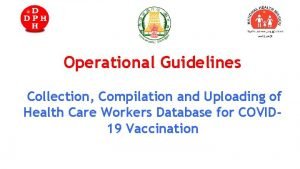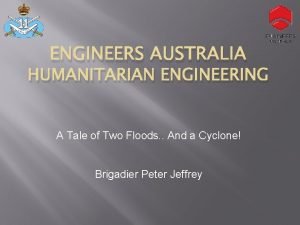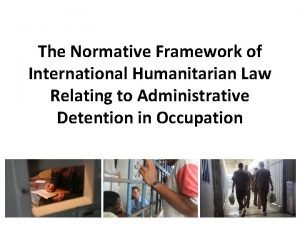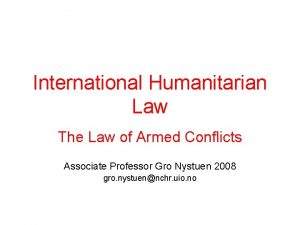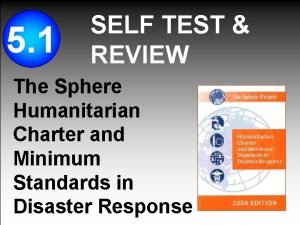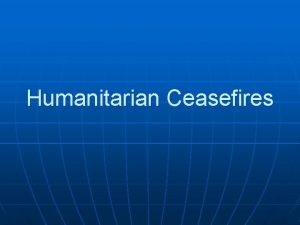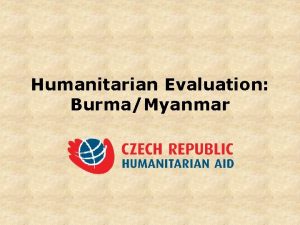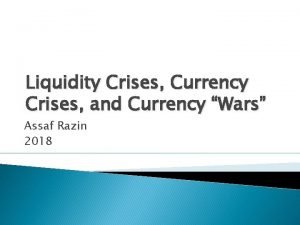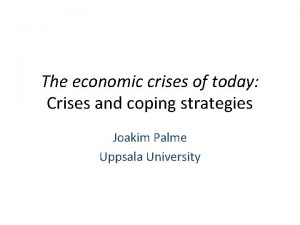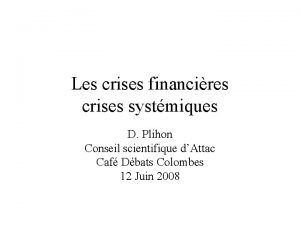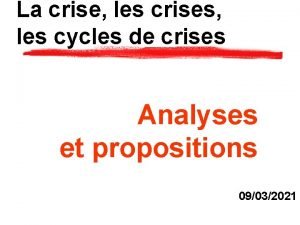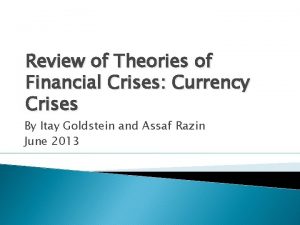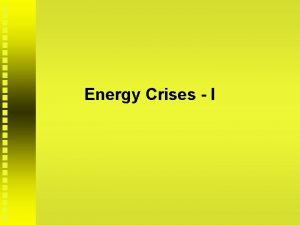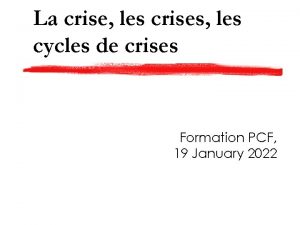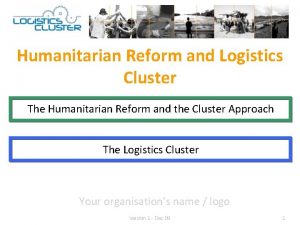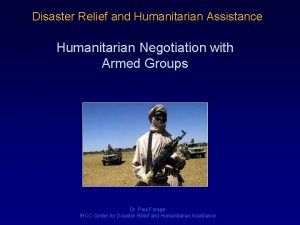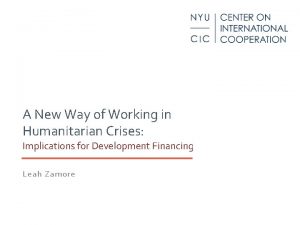Scene setting humanitarian crises and evaluation issues Evaluation
























- Slides: 24

Scene setting: humanitarian crises and evaluation issues Evaluation Practice Exchange Seminar 13 th March 2015 Anne-Claire Luzot Senior Evaluation Officer, WFP Office of Evaluation

Structure of the presentation • Humanitarian crises and response • Humanitarian action • Evaluating humanitarian action (EHA)

Humanitarian crises

Range of humanitarian crises Natural disasters & human induced crises Sudden & slow-onset Tsunami vs Syria crisis Earthquake vs drought Short-term & protracted Floods vs Darfur Rural & urban Earthquake in rural Pakistan vs Earthquake in Haiti Overall increasing in numbers and in complexity

Funding requirements and people in need In 2013, 148 million people affected by natural disasters or displaced by conflict In 10 yrs People in need multiplied by 2 Requirements multiplied by 4 http: //www. unocha. org/data-and-trends-2014/img/graph-funding-people. png

Humanitarian aid funding

ODA and HA (2010 -12) in Million USD ODA 25000 20000 Afghanistan 15000 Kenya 10000 13 of the 20 most important recipient of ODA are also the main recipient of HA over the period Ethiopia Pakistan Haiti Iraq DRC OPT Ivory Coast 5000 Indonesia South Sudan Mali 0 0 1000 2000 3000 4000 5000 HA Source: Global Humanitarian Assistance Report 2014

UN Agencies active in the humanitarian sector in 2015 (and maybe more) UNDSS UNESCO UNAIDS UNICEF UN WOMEN FAO UN OCHA UNWRA UN HCR UNODC UN HABITAT UNDP WFP UNMAS ILO UNFPA UNIDO WHO UNOPS More than 20 UN Agencies are regularly active in the humanitarian sector Source: UN OCHA FTS

Humanitarian aid funding key trend Year Funding requirements (in billions $) Number of Agencies involved 2005 +/- 6 +/- 165 2010 +/- 11 +/- 625 2013 +/- 700 Increasing fragmentation of humanitarian action

Complex and evolving international humanitarian system Complexity Evolving system Increasingly complex crises Humanitarian reform (2005) (Clusters, CERF) Multitude of actors with varied experiences, profiles and perspectives Transformative Agenda (2011) (system wide protocols)

Humanitarian action

What do we mean by humanitarian action? “Action taken with the objective of saving lives and livelihoods, alleviating human suffering and maintaining human dignity during and after humaninduced crises and natural disasters, as well as to prevent and prepare for them” (ALNAP, Evaluating Humanitarian Action pilot guide)

Neutrality Humanitarian actors must not take Human suffering must be addressed sides in hostilities or engage in wherever found. The purpose of controversies of a political, racial, Humanitarian Action is to protect life religious or ideological nature and health and ensure respect for human beings Humanitarian Principles Impartiality Independence Humanitarian action must be carried out on the basis of need alone, giving Humanitarian action must be priority to the most urgent cases of autonomous from the political, distress and making no distinctions on economic, military or other objectives the basis of nationality, race, gender, that any actor may hold with regard to areas where humanitarian action is religious belief class or political being implemented opinion

Humanitarian Principles Adopted in 1965 by the Red Cross and Red Crescent Movement Neutrality, Impartiality and Humanity adopted by General Assembly in 1991 Independence adopted by General Assembly in 2004

Humanitarian Standards Provide a normative reference point, against which to evaluate Can help to break down humanitarian action into smaller components that are easier to assess Most widely used in evaluation are the Sphere Standards - Core standards (People and Process) - Technical standards covering various sectors

Humanitarian action

Evaluation of Humanitarian Action (EHA) • Investment in EHA from mid-to late 1990 s • associated with increasing demand for accountability in the humanitarian aid sector • triggered by growing concern over the poor and varied performance of humanitarian agencies.

Humanitarian evaluation criteria Appropriateness of humanitarian activities to local needs Coverage Assistance reaching all affected population groups Coherence Extent to which there is consistency between development and humanitarian aid Connectedness take longer term and interconnected problems into account Coordination With all actors promoting synergies and avoiding duplication and gaps

Evaluation of Humanitarian Action (EHA) – current status Coordination of EHA still a challenge eg Haiti, Somalia. • Only 2 system-wide evaluations: Rwanda and tsunami • But increasing interest for joint evaluations. For instance the Inter-Agency Evaluations of Humanitarian Action (IAEHA – system wide level 3 emergencies)

Evaluation of Humanitarian Action (EHA) – current status Current concerns in EHA: • How to move away from a development framework to evaluation? • How to improve the record of evaluation utilization? • Developing more learning-oriented approaches eg realtime evaluations or operational reviews • Commitment to strengthening accountability to affected populations ?

Common challenges (1) • Most evaluation limitations are magnified • Lack of planning documents, unclear objectives, missing theories of change, early plans quickly outdated, moving targets What do you evaluate against? • Lack of data, including baseline data Within the short timeframe of an evaluation, and in the absence of usable monitoring data, how do you collect all the data you need without a baseline as reference?

Common challenges (2) • High turnover of stakeholders (staff, counterparts, partners, etc. ) • Population movements Difficult to find key informants • Insecurity means lack of access in conflict environments How can evaluators reach the affected population?

Gaps / issues • How to assess the humanitarian principles? • Innovation in evaluation methods to adapt to humanitarian context • Accountability to affected population • Ethics of evaluation in a climate of trauma, abuse and violence, and breakdown of trust

Thank you
 The crises
The crises Enkelvoud examples
Enkelvoud examples Ee.humanitarian response.info/x/vpdlixjf
Ee.humanitarian response.info/x/vpdlixjf Humanitarian work psychology
Humanitarian work psychology Humanitarian projects in prague for youth
Humanitarian projects in prague for youth Wcag
Wcag Humanitarian programme cycle 2021
Humanitarian programme cycle 2021 Afjrotc awards and decorations
Afjrotc awards and decorations Cadet humanitarian award
Cadet humanitarian award Humanitarian engineers in cape york
Humanitarian engineers in cape york International humanitarian law icrc
International humanitarian law icrc International humanitarian law icrc
International humanitarian law icrc International humanitarian law notes
International humanitarian law notes Khalifa humanitarian foundation
Khalifa humanitarian foundation Domistan
Domistan Humanitarian work psychology
Humanitarian work psychology Act 3 scene 1 romeo and juliet summary
Act 3 scene 1 romeo and juliet summary Setting of act 1 scene 4 romeo and juliet
Setting of act 1 scene 4 romeo and juliet Macbeth scene by scene summary
Macbeth scene by scene summary Macbeth act 1 summary
Macbeth act 1 summary Macbeth act 1 scene 4-7
Macbeth act 1 scene 4-7 Blanche characterization
Blanche characterization Act one scene one othello summary
Act one scene one othello summary Act 2 scene 4 macbeth
Act 2 scene 4 macbeth Act 1 scene 3 hamlet
Act 1 scene 3 hamlet


